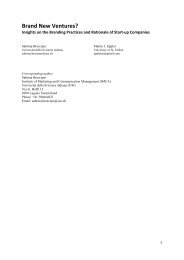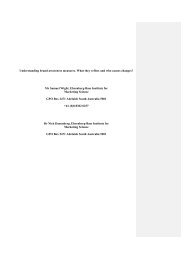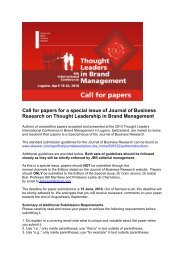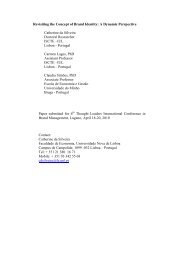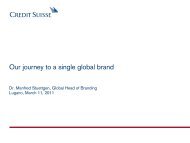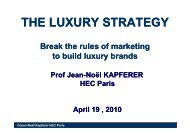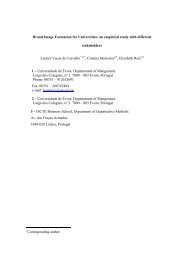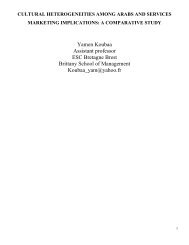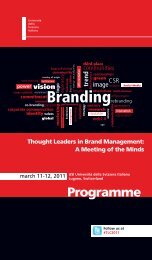Esch, Franz-Rudolf, Winter, Kai, Limited Editions
Esch, Franz-Rudolf, Winter, Kai, Limited Editions
Esch, Franz-Rudolf, Winter, Kai, Limited Editions
Create successful ePaper yourself
Turn your PDF publications into a flip-book with our unique Google optimized e-Paper software.
LIMITED EDITIONS –EVALUATION AND RECIPROCAL EFFECTS ON FMCG BRANDS<strong>Franz</strong>-<strong>Rudolf</strong> <strong>Esch</strong>, Justus-Liebig University of Gießen<strong>Kai</strong> <strong>Winter</strong>, Justus-Liebig University of GießenCorresponding author:<strong>Franz</strong>-<strong>Rudolf</strong> <strong>Esch</strong>Justus-Liebig University of GießenLicherstraße 6635394 GießenEmail: <strong>Franz</strong>-<strong>Rudolf</strong>.<strong>Esch</strong>@imk-giessen.deTel.: +49 0641 9922401Fax: +49 0641 9922409
2ABSTRACT<strong>Limited</strong> <strong>Editions</strong> are a widely used type of line extensions to introduce new products in theFast-Moving-Consumer-Goods business. In this process an exceptional, limited availablevariant is added to the permanent offers of a product line. Despite the meanwhile wide use ofthis strategy in marketing there is almost no scientific discussion about limited editions. Thisarticle focuses on how consumers react to limited editions. Based on exploration-, scarcityandcategorization-theory, effects of exploration seeking and processing depth are analysed.Additionally reciprocal effects of limited editions on the parent brand are examined.Keywords: limited editions, exploration seeking, scarcity, categorisation.
3LIMITED EDITIONS –EVALUATION AND RECIPROCAL EFFECTS ON FMCG BRANDSINTRODUCTION<strong>Limited</strong> <strong>Editions</strong> characterise a special form of line extensions. On the one hand, they differfrom typical extensions by their limited availability. This is indicated by labels like “limitededition” or “only for a short time”. On the other hand, limited editions are characterised byatypical variations of product attributes. An example is given by Magnum’s limited edition “5Senses”. The restricted availability of this special variation is illustrated by “<strong>Limited</strong> Edition”.Extraordinary varieties and atypical design elements support a clear distinction frompermanent offers (Fig. 1).- please place Fig. 1 about here -Whereas limited editions in high involvement categories, such as watches or art prints, lookback on a long tradition (Amaldoss and Join, 2008; Franke and Schreier, 2008), in recentyears this kind of strategy has been used increasingly in fast-moving-consumer-goods(FMCG)-categories as well. Companies use the limited-edition-strategy especially becauseof the additional growth potential and the possibility to distinguish one’s brand from theothers (Kirsche, 2005). The number of limited edition launches in the U.S. food- andbeverage-sector increased from 2001 to 2004 about 87% to 230 (Banasiak, 2005). Forconsumers, these products are very attractive because they offer something new and exciting(Banasiak, 2005; Oller, 2006; Theodore, 2004). In FMCG-categories, consumers show adistinct openness to innovations and related desires for variety and new sensory experiences.<strong>Limited</strong> editions succeed to meet these desires by their extraordinary product characteristics(Banasiak, 2005; Kirsche, 2005). The restricted availability indicates a “use-it-or-lose-it”-situation and is therefore an additional sales appeal (Oller, 2006; Theodore, 2004).RESEARCH OBJECTIVEIn spite of its high practical relevance as a special form of product line extension, there is upto now a lack of scientific discussion about the effects of limited editions on the consumer.Some authors list possible effects, like addressing the need for stimulation or positivefeedback effects to the parent brand image (e.g. Banasiak, 2005; Oller, 2006). A theoreticalfoundation respectively empirical discussion is missing. The following research issues aremain subjects of this article: What are the fundamental parameters for the evaluation oflimited editions in FMCG-categories? To what extent may the regular brand benefit frompositive feedback effects of the limited edition?THEORETICAL BACKGROUNDThe theories used, derive from the characteristics of limited editions. Effects related to thelimited availability of a product arise from theoretical approaches about scarcity. A scientificdiscussion concerning the impact of atypical products follows from categorisation theory. Inaddition, exploration theoretical approaches, which discuss the role of need for stimulation,are used.Exploration tendency: The desire for stimulation by diversification and new sensoryexperiences is assumed to be a basic motivation for buying limited editions (Banasiak, 2005;Oller, 2006). In exploration research this issue is called exploration tendency and contains
ehavioural tendencies which help to regulate arousal and result from the motivation forstimulation seeking (Raju, 1980). Exploration tendency is a temporary relatively stablepersonality trait with varying intensity between individuals (Baumgartner and Steenkamp,1996; Grande, 2005; Joachimsthaler and Lastovicka, 1984; Van Trijp et al., 1996). It issupposed that there are different levels of optimal stimulation among individuals (Hebb,1955; Leuba, 1955; Maier et al., 2007). Exploration seekers show a high optimum. They willsearch more likely for stimulation than exploration avoiders, who are characterised by a loweroptimum respectively a preference for familiar stimuli and situations (Baumgartner andSteenkamp, 1996; Raju, 1980; Van Trijp et al., 1996). As a result of the exploration tendency,explorative behaviours aim at the variations of the consumers’ surrounding attractions andact as a stimulant to the organism (Baumgartner and Steenkamp, 1996; Berlyne, 1960; Raju,1980). Van Trijp et al. (1996) show that explorative behaviour is expected particularly inthose product categories with low product involvement (Hoyer and Ridgway, 1984). Becauseof their extraordinary characteristics limited editions in FMCG-categories are expected toshow a particularly high potential for stimulation. Therefore, they may primarily meet theacceptance of exploration seekers.Scarcity heuristics: Several authors discuss the question to what extent scarcity as aheuristic cue has a positive impact on product evaluation (“scarcity effect”) (Cialdini, 1993;Lynn, 1989, 1992; Stock and Balachander, 2005). Cialdini (1993; 2001) assumes a“scarce = attractive”-heuristic, with consumers drawing direct conclusions from scarcity toattractiveness (Cialdini, 1993; 2001). The information about limited product availabilityinitiates a standardised, cognitively hardly controlled sequence of behaviour which causes alonging for the product (Cialdini, 1993). According to Lynn (1992), scarcity is not directlyresulting in increased attractiveness. In fact, consumers use a “scarce = expensive”-heuristicand infer from limited availability to a higher price (Lynn, 1992). An increase inattractiveness due to scarcity may be expected only if consumers prefer costly products ratherthan cheap alternatives, e.g. to demonstrate higher status. Concerning limited editions inFMCG-categories, it can be assumed that consumers will take the indication of limitedavailability as a heuristic stimulus as well. However, it is unlikely that one of the abovedescribed heuristics will be activated. The arousal of a desire for the product “at the push of abutton” is contradictory to other views about scarcity effects. According to several authors(e.g. Brannon and Brock, 2001; Brehm, 1966; Folger, 1992; McConnell et al., 2000;Zeelenberg and Pieters, 2007), cognitive processes are fundamental for increasedattractiveness caused by scarcity. This is contrary to Cialdini’s (1993) assumption. However,effects shown by Lynn (1992) are primarily expected in high involvement product categorieswhere products serve as status symbols (Lynn, 1989). Concerning FMCGs, a scarcityinformation may rather lead to a “scarce = novel”-heuristic. This heuristic assumes thatconsumers learn about the limited edition characteristics of novelty and speciality in FMCGcategories. Therefore, consumers draw conclusions from limited availability to the offers’distinctiveness. In turn, depending on individual tendencies to exploration, this leads toincreased perceived product attractiveness.Categorisation: Categorisation-theoretic considerations provide conclusions about reciprocaleffects of limited editions towards the parent brand. The process of categorisation containsthe identification of an object as a member of a class of objects on the basis of similarities(Ozanne et al., 1992; Pavelchak, 1989; Rosch and Mervis, 1975). A brand category can beunderstood as a group of several distinguishable products bearing the same brand name(Boush, 2001; Boush and Loken, 1991). Similar to categories in general, the members of abrand category show a graded structure. “Some products are more representative of a brandcategory than are others” (Boush and Loken, 1991). All of a brand’s existing products as wellas new ones can be described in terms of how much they are (a)typical for the brand (Joiner4
5and Mason, 2007). Within the scope of product categorisation, both assimilation- or contrasteffectscan be caused (Lee, 1995; Wänke et al., 2001). A contrast-effect usually occurs if astimulus related to a context-stimulus is categorised further away than in absence of thiscontext-stimulus. Assimilation describes the fact that a relation to a context stimulus increasesperceived similarity (Frey and Greif, 1994). Assimilation effects occur if a product issuccessfully identified as a member of a certain brand (Fiske and Neuberg, 1990; Schwarzand Bless, 1992). On the one hand, this implies a transfer of characteristics from the brand tothe product (Park et al., 1991; Reddy et al., 1994). On the other hand, characteristics of theproduct become a fundamental part of the brands’ mental representation and lead to a changeof the brands’ image (Loken et al., 1993; Romeo, 1991; Thorbjǿrnsen, 2005). For limitededitions it can be expected that they change the parent brands’ mental representation throughtheir characteristics, like for example the novelty, or their overall attractiveness in productcategories with a tendency to exploration.HYPOTHESESMeaning of exploration tendency for the effect of a product limitation: Concluding fromthe considerations about the impact of scarcity, consumers in the FMCG-sector use scarcitysignals as a heuristic cue to infer novel characteristics of the product. The perceived noveltyshould have a positive effect on product evaluation, especially in case of high explorationtendency. The following hypotheses can be derived from these conclusions:Hypothesis 1: Marking a product with an indication for limitation, increases perceivedproduct novelty.Hypothesis 2: Exploration seekers show a) a more positive attitude respectively b) a moredistinctive behavioural intention towards a limited product than exploration avoiders.Hypothesis 3: The scarcity effect appears only with exploration seekers. An indication forlimitation causes a) an increased product evaluation respectively b) a more distinctive behaviouralintention with exploration seekers. There is no positive impact on product evaluationand behavioural intention by limitation with exploration avoiders.Meaning of the depth of processing for the effect of a limited edition: Cialdini’s (1993)point of view that scarcity creates desire “at the push of a button” is only hard to apply for thelimited editions regarded in this article. It can be assumed that the effect of limited editions ismainly influenced by cognitive processes. The following hypotheses can be deduced:Hypothesis 4: A deeper processing of the limited edition leads a) to a positive attitudetowards the product, respectively b) to a stronger behavioural intention than a superficialprocessing.Hypothesis 5: The positive scarcity effect occurs with an atypically designed product only bydeeper processing. In this case, an indication of limitation leads to a) a more positive attitudetowards the product, respectively b) a stronger behavioural intention. There occurs no scarcityeffect with a low depth of processing.Reciprocal effects of the limited edition to the parent brand: The inclusion of the limitededition leads to a change of the mental brand representation. It can be assumed that there is apositive evaluation for limited editions in those FMCG-categories which tend to exploration.However, positive feedback effects on the overall-attitude can be expected only for weakbrands, because strong brands are assumed to already have a stable attitude (Keller and Aaker,1992). Moreover, the quality of novelty, which is associated with limited editions, leads to achanging attitude towards the brand. As in this case evaluations of a specific level aretouched, there is also a possibility of a change in judgement over a strong brand (Loken andRoedder John, 1993). The following hypotheses can be deduced:
6Hypothesis 6: The launch of a limited edition under a weak brand has a positive effect on thebrand’s attitude. In case of a strong brand, the attitude towards the brand remains the same.Hypothesis 7: The introduction of a limited edition has a positive effect on the perceivedcreativity of the brand, regardless of the strength of the brand.RESULTSFor the verification of the hypotheses, three experiments were carried out. An evaluationtakes place through analyses of variance.Experiment I: The aim of the first experiment was to examine in what way the effect ofproduct limitation, which is characteristic for limited editions, is dependent on the explorationtendency of the consumers. The design of the study is a 2x2-factorial between-subject-design.On the one hand, the limitation has been varied as one factor (with vs. without indication oflimitation). An illustration of the product line of the fictitious frozen pizza brand Osseo waspresented to the test persons with the test product “Mozzarella-Rocket-Parma ham” as well asthe two standard varieties (“Margherita” and “Salami”). In comparison with the experimentalsituation “no limitation”, in the situation “with limitation” additional information “<strong>Limited</strong>Edition – Only for a Short Time” were provided to the product “Mozzarella-Rocket-Parmaham“ (see appendix). On the other hand, a division of the examination participants accordingto their exploration tendency took ex post place (high vs. low exploration tendency). Thistendency has been operationalised by using the “Exploratory Acquisition of Products” (EAP)-Index (Baumgartner and Steenkamp 1996). The differentiation between exploration seekerand exploration avoider is made on the basis of a median split (Menon and Kahn, 1995). Intotal, 120 students of a German university were interviewed. For the dependent variable, theperceived novelty of the product, the attitude towards the product as well as the trial interestwere captured on the basis of nine-level bipolar items (see appendix). In addition, the productinvolvement for frozen pizza was included as a possible disturbance variable. Results ofexperiment I: Through the signalling of the limited availability, the altogether perceivednovelty of the test product increases to a significant extent (F 1.116 =5.694, p
72004; Shiv and Huber, 2000). The manipulation of the depth of processing was monitoredthrough a task-involvement-index (Gürhan-Canli and Maheswaran, 1998; Maoz and Tybout,2002). Again, the attitude towards the product and the trial interest were questioned asdependent variables. The product involvement as well as the tendency to exploration weredefined as disturbance variables. Results of experiment II: With deeper processing of thelimited edition there was a significantly more positive attitude judgement (F 1.57 =9.083, p
8impact of a product limitation. To generate a positive scarcity effect at the PoS, it isnecessary that customers also recognise the limitation. Therefore, it has to be ensured thataccording to the product design and also to the PoS-materials (e.g. trays and displays), theproduct limitation is communicated appropriately visibly to the consumer. The impact of aproduct limitation has also to be taken into account for product tests prior to a launch. To getvalid test results, it is necessary to already inform the consumers in market research testsabout the planned limitation of the product. Another interesting finding is that the evaluationof the limited edition is significantly influenced by processing depth. A positive scarcityeffect only occurs if there is a more intensive cognitive examination. Therefore, Cialdini’s(1993) point of view that a desire, which results out of scarcity, can be aroused “at the push ofa button” has to be rejected for the limited editions regarded in this article. The consequenceis a particular relevance for those activities that are useful for a more intensive turn to theproduct at the PoS. On the other hand, especially limited editions could suffer if PoS activitiesprescind too much from the product. Finally, it has been found that the brand can profit fromthe reciprocal effects of a limited edition. <strong>Limited</strong> editions are an effective strategy forbrands which aim to increase the perceived brand creativity. In addition, they provide anopportunity for weak brands to improve the overall-attitude towards the brand.LIMITATIONS AND FUTURE RESEARCHFor the generalisation of the obtained findings it has to be restrictively considered thatexclusively students were questioned. Studies about the exploration tendency have shown thatparticularly for younger consumers (Givon, 1984; Kumar and Trivedi, 2006; Raju, 1980), orrather for those with a higher level of education (Raju, 1980) an above-average tendency toexplorative behaviour exists. Therefore, the above-average high tendency to exploration andtherewith the acceptance of limited editions is expected for the group of students. In futurestudies, further sections of population can be examined concerning their acceptance of limitededitions. In these studies, the range of product categories is restricted to frozen pizza andbiscuits. The results should not be easily applied onto other product categories. With theconsideration of other categories in the low involvement area, the external validity of theobtained findings could be increased. An important factor which leads to a differentacceptance on limited editions in different product categories may be found in the categoryrelatedtendency to exploration.
9REFERENCESAmaldoss W, Jain S. Trading Up: A Strategic Analysis of Reference Group Effects.Marketing Science 2008; 27 (5): 932-942.Banasiak K. Here Today, Gone Tomorrow. Food Technology 2005; 59 (4): 40-43.Baumgartner H, Steenkamp JBEM. Exploratory Consumer Buying Behavior:Conceptualization and Measurement. International Journal of Research in Marketing1996; 13 (2): 121-137.Berlyne DE. Conflict, Arousal, and Curiosity. New York: McGraw-Hill, 1960.Boush DM, Loken B. A Process-Tracing Study of Brand Extension Evaluation. Journal ofMarketing Research 1991; 18 (February): 16-28.Brannon LA, Brock TC. Limiting Time for Responding Enhances Behavior Corresponding tothe Merits of Compliance Appeals: Refutations of Heuristic-Cue Theory in Service andConsumer Settings. Journal of Consumer Psychology 2001; 10 (3): 135-146.Brehm JW. A Theory of Psychological Reactance. New York/London: Academic Press, 1966.Cialdini RB. Influence: The Psychology of Persuasion. New York: William Morrow, 1993.Cialdini RB. Harnessing the Science of Persuasion. Harvard Business Review 2001; 79 (9):72-79.Drolet A, Luce MF. The Rationalizing Effects of Cognitive Load on Emotion-Based TradeoffAvoidance. Journal of Consumer Research 2004; 31 (June): 63-77.Fiske T, Neuberg L. A Continuum of Impression Formation, from Category-Based toIndividuating Processes: Influences of Information and Motivation on Attention andInterpretation. In: Zana M, editor. Advances in Experimental Social Psychology, vol. 23.San Diego: Academic Press, 1990. pp. 1-74.Folger R. On Wanting What We Do Not Have. Basic and Applied Social Psychology 1992;13 (1): 123-133.Franke N, Schreier M. Product Uniqueness as a Driver of Customer Utility in MassCustomization. Marketing Letters 2008; 19 (2): 93-107.Givon M. Variety Seeking Through Brand Switching. Marketing Science 1984; 3 (1): 1-22.Grande I. Dimensions in Scales for Measuring Exploratory Tendencies and StimulationLevels in Consumers: A Cross-Cultural Comparison of the USA and Spain. Journal ofConsumer Behavior 2005; 4 (5): 363-373.Gürhan-Canli Z, Maheswaran D. The Effects of Extensions on Brand Name Dilution andEnhancement. Journal of Marketing Research 1998; 35 (November): 464-473.Hebb DO. Drives and the C.N. (Conceptual Nervous System). Psychological Review 1955;62 (4): 243-254.Hoyer WD, Ridgway NM. Variety Seeking as an Explanation for Exploratory PurchaseBehavior: A Theoretical Model. Advances in Consumer Research 1984; 11: 114-119.Joachimsthaler EA, Lastovicka JL. Optimum Stimulation Level – Exploratory BehaviorModels. Journal of Consumer Research 1984; 11 (December): 830-835.Joiner C, Mason G. Brands as Categories: Graded Structure and Its Determinants. Advancesin Consumer Research 2007; 34: 500-506.Keller KL, Aaker DA. The Effects of Sequential Introduction of Brand Extensions. Journal ofMarketing Research 1992; 29 (February): 35-50.Kirsche M. <strong>Limited</strong>-Edition Candy Provides Short – but Sweet – Sales Boosts. Drug StoreNews. Consumables 2005; 04/11/2005: 45.Kumar A, Trivedi M. Estimation of Variety Seeking for Segmentation and Targeting: AnEmpirical Analysis. Journal of Targeting, Measurement and Analysis for Marketing 2006;15 (1): 21-29.
Lee M. Effects of Schema Congruity and Involvement on Product Evaluations. Advances inConsumer Research 1995; 22: 210-216.Leuba C. Toward some Integration of Learning Theories: The Concept of OptimalStimulation. Psychological Reports 1955; 1: 27-33.Loken B, Roedder JD. Diluting Brand Beliefs: When Do Brand Extensions Have a NegativeImpact? Journal of Marketing 1993; 57 (July): 71-84.Lynn M. Scarcity Effects on Desirability: Mediated by Assumed Expensiveness? Journal ofEconomic Psychology 1989; 10 (2): 257-274.Lynn M. Scarcity’s Enhancement of Desirability: The Role of Naive Economic Theories.Basic and Applied Social Psychology 1992; 13 (1): 67-78.Maier A, Vickers Z, Inman, JJ. Sensory-Specific Satiety, its Crossovers, and SubsequentChoice of Potato Chip Flavours. Appetite 2007; 49: 419-428.Maoz E, Tybout AM. The Moderating Role of Involvement and Differentiation in theEvaluation of Brand Extensions. Journal of Consumer Psychology 2002; 12 (2): 119-131.McConnell AR, Niedermeier KE, Leibold JM, El-Alayli AG, Chin PP, Kuiper, NM. What IfI Find it Cheaper Someplace Else? Role of Prefactual Thinking and Anticipated Regret inConsumer Behavior. Psychology and Marketing 2000; 17 (4): 281-298.Menon S, Kahn BE. The Impact of Context on Variety Seeking in Product Choices. Journal ofConsumer Research 1995; 22 (December): 285-295.Oller S. Short and Sweet – <strong>Limited</strong>-Edition Candy is Keeping Things Interesting in theCategory, but for how Long? CSP 2006; February: 72-80.Ozanne JL, Brucks M, Grewal D. A Study of Information Search Behavior during theCategorization of New Products. Journal of Consumer Research 1992; 18 (March): 452-463.Park CW, Milberg S, Lawson R. Evaluation of Brand Extensions: The Role of ProductFeature Similarity and Brand Concept Consistency. Journal of Consumer Research 1991;18 (September): 185-193.Pavelchak MA. Piecemeal and Category-Based Evaluation: An Idiographic Analysis. Journalof Personality and Social Psychology 1989; 56 (3): 354-363.Raju PS. Optimum Stimulation Level: Its Relationship to Personality, Demographics, andExploratory Behavior. Journal of Consumer Research 1980; 7 (December): 272-282.Reddy K, Holak L, Bhat S. To Extend or not to Extend: Success Determinants of LineExtensions. Journal of Marketing Research 1994; 31 (May): 243-262.Romeo JB. The Effects of Negative Information on the Evaluations of Brand Extensions andthe Family Brand. Advances in Consumer Research 1991; 18: 399-406.Rosch E, Mervis CB. Family Resemblances: Studies in the Internal Structure of Categories.Cognitive Psychology 1975; 7 (4): 573-605.Schwarz N, Bless H. Constructing Reality and Its Alternatives: An Inclusion/ExclusionModel of Assimilation and Contrast Effects in Social Judgment. In: Martin LL, Tesser A,editors. The Construction of Social Judgments. Hillsdale, N.J.: Lawrence ErlbaumAssociates, Inc., 1992. pp. 217-245.Sherif M, Taub D, Hovland CI. Assimilation and Contrast Effects of Anchoring Stimuli onJudgements. Journal of Experimental Psychology 1958; 55: 150-155.Shiv B, Huber J. The Impact of Anticipating Satisfaction on Consumer Choice. Journal ofConsumer Research 2000; 27 (September): 202-216.Theodore S. For a <strong>Limited</strong> Time Only. Beverage Industry 2004; 95 (9): 6.Thorbjørnsen. H. Brand Extensions: Brand Concept Congruency and Feedback EffectsRevisited. Journal of Product and Brand Management 2005; 14 (4): 250-257.10
Van Trijp HCM, Hoyer WD, Inman J. Why Switch? Product Category-Level Explanations forTrue Variety-Seeking Behavior. Journal of Marketing Research 1996; 33 (August): 281-292.Wänke M, Bless H, Igou ER. Next to a Star: Paling, Shining, or Both? Turning InterexemplarContrast Into Interexemplar Assimilation. Personality and Social Psychology Bulletin2001; 27 (1): 14-29.Zeelenberg M, Pieters R. A Theory of Regret Regulation 1.0. Journal of ConsumerPsychology 2007; 17 (1): 3-18.11
Fig. 1. Magnum product line including <strong>Limited</strong> Edition12
133,0000Perceived Novelty2,50502,00001,50501,00000,50500,00000,51nolimitation*1,13limitation** Overall (no differentiationbetween exploration seekerand exploration avoider)3,00002,50502,00001,50501,00000,5050Attitude towards the Product1,330,792,141,123,00002,50502,00001,50501,00000,50501,731,30Trial Interest2,771,140,0000nolimitationlimitation0,0000nolimitationlimitationExploration SeekerExploration AvoiderFig. 2. Results of Experiment I3,00002,50502,00001,50501,0000Attitude towards the Product2,321,35 1,431,213,00002,50502,00001,50501,00002,311,79Trial Interest2,801,610,50500,50500,0000nolimitationlimitation0,0000nolimitationlimitationHigh depth of processingLow depth of processingFig. 3. Results of Experiment II
143,00002,50502,00001,5050Attitude towards the Brand2,10 2,251,842,00001,50501,00000,5050Brand Creativity1,891,251,00000,50500,00000,90before launching<strong>Limited</strong> Editionafter launching<strong>Limited</strong> Edition0,0000-0,50-1,00-0,74-0,90before launching<strong>Limited</strong> Editionafter launching<strong>Limited</strong> EditionWeak BrandStrong BrandFig. 4. Results of Experiment IIIAPPENDIXStimuli of Experiment 1
15Dependent Variable Measurement Cronbachs aPerceived NoveltyAttitude towards theProductTrial InterestBrand FitAttitude towards theBrandBrand CreativityMeasured by the following sets of adjectives:dull/exciting, routine/fresh, conventional/unconventional,predictable/novel, usual/unusual, ordinary/unique,commonplace/original (9-point scale)(Andrews/Smith, 1996)Measured by the following scale items::good/bad, like/dislike, attractive/unattractive, likeable/dislikable, high quality/poor quality (9-point scale)(Hanson/Biehal, 1995)How great is your interest to try the Product X?(-4 = not interested, 4 = very interested)(Fennis/Bakker, 2001)To what extend do you think the product fits to the Brand X?(-4 = not at all, 4 = very well)(Chakravarti/MacInnis/Nakamoto, 1990)Measured by the following scale items::good/bad, like/dislike, attractive/unattractive, likeable/dislikable, high quality/poor quality (9-point scale)(Hanson/Biehal, 1995)What is your opinion regarding Brand X on each of thefollowing attributes?1. trendy, 2. modern, 3. cute, 4. creative, 5. fancy(-4 = not applicable, 4 = applicable)(Mäder, 2005)Operationalisation of dependent variablesExperiment 1:a= 0,95Experiment 1:a= 0,89Experiment 2:a= 0,88––Experiment 3:Before-Measurement:a= 0,90After-Measurement:a= 0,91Experiment 3:Before-Measurement :a= 0,93After-Measurement :a= 0,96



